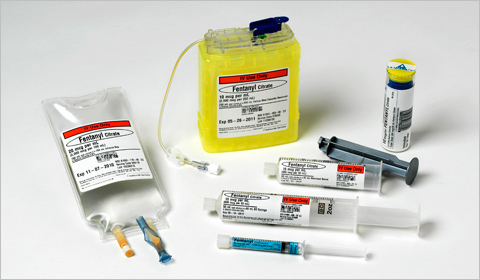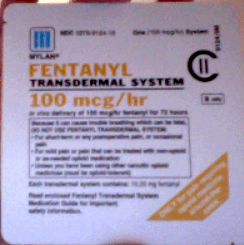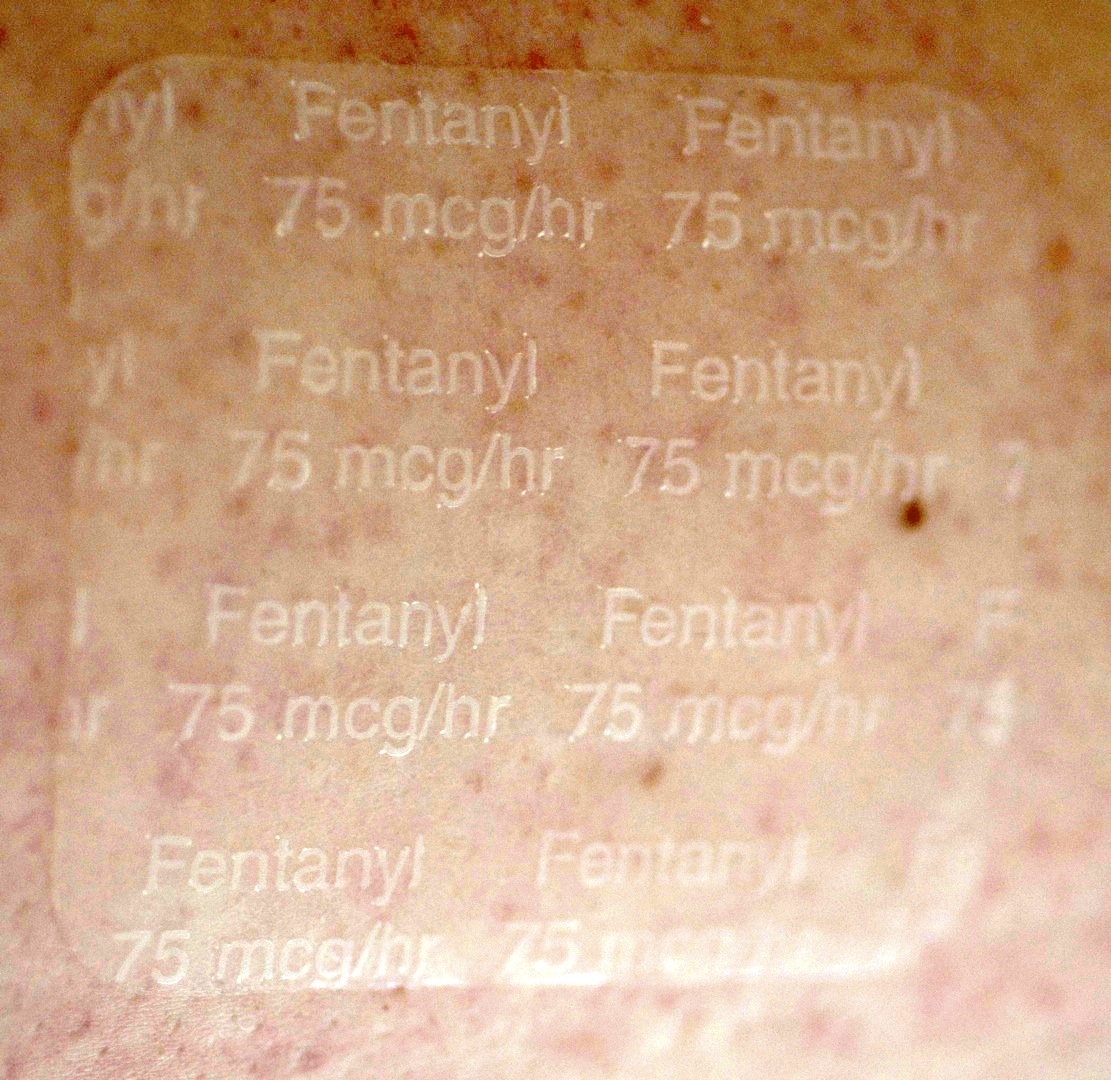Fentanyl: Difference between revisions
GrimReaper (talk | contribs) |
|||
| Line 1: | Line 1: | ||
Fentanyl is a synthetic opiate analgesic with a rapid onset and short duration of action. It is a strong agonist at the μ-opioid receptors and is historically used to treat breakthrough pain. Fentanyl is approximately 100 times more potent than morphine, and is commonly used as a patch. The patches work by releasing fentanyl into body fats, which then slowly release the drug into the bloodstream over 48 to 72 hours, allowing for long-lasting relief from pain. | '''Fentanyl''' is a synthetic opiate analgesic with a rapid onset and short duration of action. It is a strong agonist at the μ-opioid receptors and is historically used to treat breakthrough pain. Fentanyl is approximately 100 times more potent than morphine, and is commonly used as a patch. The patches work by releasing fentanyl into body fats, which then slowly release the drug into the bloodstream over 48 to 72 hours, allowing for long-lasting relief from pain. | ||
== History == | |||
Fentanyl was first synthesized by Paul Janssen in 1960. Fentanyl was introduced in patch form in the mid 1990s, shortly followed by lollipop form. As of 2012 fentanyl was the most widely used synthetic opioid in clinical practice. | Fentanyl was first synthesized by Paul Janssen in 1960. Fentanyl was introduced in patch form in the mid 1990s, shortly followed by lollipop form. As of 2012 fentanyl was the most widely used synthetic opioid in clinical practice. | ||
| Line 97: | Line 97: | ||
<br clear="all"/> | <br clear="all"/> | ||
== Legal == | == Legal status== | ||
In most countries, fentanyl is illegal to sell without a license and illegal to buy or possess without a license or prescription. | In most countries, fentanyl is illegal to sell without a license and illegal to buy or possess without a license or prescription. | ||
*Europe: http://europa.eu/legislation_summaries/customs/l33215_en.htm | |||
*USA: Regulated as a schedule II opiate. | |||
*Canada: Regulated as schedule I. | |||
*Australia: Fentanyl is a border controlled substance under Criminal Code Act 9.1.314 and is additionally controlled by several states and territories. | |||
Regulated as a schedule II opiate. | |||
Regulated as schedule I. | |||
Fentanyl is a border controlled substance under Criminal Code Act 9.1.314 and is additionally controlled by several states and territories. | |||
[[Category:Drugs]] | [[Category:Drugs]] | ||
Revision as of 04:37, 10 March 2015
Fentanyl is a synthetic opiate analgesic with a rapid onset and short duration of action. It is a strong agonist at the μ-opioid receptors and is historically used to treat breakthrough pain. Fentanyl is approximately 100 times more potent than morphine, and is commonly used as a patch. The patches work by releasing fentanyl into body fats, which then slowly release the drug into the bloodstream over 48 to 72 hours, allowing for long-lasting relief from pain.
History
Fentanyl was first synthesized by Paul Janssen in 1960. Fentanyl was introduced in patch form in the mid 1990s, shortly followed by lollipop form. As of 2012 fentanyl was the most widely used synthetic opioid in clinical practice.
Dosage
Approximately 100 micrograms of fentanyl is equivalent to 10mg of morphine. Rate of absorption is dependent on a number of factors. Body temperature, skin type, amount of body fat, and placement of the patch can have major effects. Fentanyl is available as a patch, nasal spray, lollipop lozenge (brand name Actiq, or colloquially "percopop"), or inhaler.
Patch
Bioavailability: varies per manufacturer; there is higher ba in the enclosed-satchel (such as Sandoz) vs the adhesive-matrix (such as Mylan) patches. The difficulty with ba in patches is separating the drug from the adhesive or carrier. It is difficult to extract a dose from either vehicle with sufficient accuracy to prevent harm in a recreational setting.
Comeup time: 20 to 60 minutes.
Duration: 24 to 72 hours; varies based upon ambient temperature, body temperature, skin salinity and perspiration, location of patch (volume of adipose tissue under the dermis), type of patch, dosage of patch. Most tolerant users will find 24 hours to be about the limit whereas naive users will more likely see 72 hours.
Medium (typical) dose: 50μg/hr + (depending on tolerance)
Patches are available in doses ranging from 12.5μg/hr to 100μg/hr, with patches previously available at strengths to 200μg/hr having been discontinued. Total fentanyl content of these patches are 1.25mg to 10mg; not all of this is available to the body from the patch and would have to be extracted using e.g., ethanol for "complete" usage.
The patch may be taken orally (sublingually) by sectioning into doses (such as 1/10th of a 10mg patch being 1mg delivered), but it is not recommended, and requires a solvent such as overproof ethanol for sufficient absorption.
Insufflated
Fentanyl powder may be snorted, but it is not recommended.
Smoked
The gel inside patches can be smoked. The powder also may be smoked, although it is not recommended.
Injected
Fentanyl is most commonly prepared in a saline solution with lactose or inositol as a buffering agent and either sold as heroin or as fentanyl itself. Fentanyl is not commonly available by itself as a powder and has low potential for abuse due to the low margin of safety with microgram-scale dosages.
Effects
The effects of fentanyl are similar to that of heroin.
Positive
- Analgesia
- Euphoria
- Feelings of relaxation
Neutral
- Sedative effects
- Changes in focus, attention
Negative
- Respiratory depression
- Diarrhea
- Nausea
- Constipation
- Dry Mouth
- Somnolence
- confusion
- weakness
- Sweating
- headache
- Fatigue
- Dizziness
- Nervousness
- Anxiety
- Urinary retention
- Hallucinations
After effects
- Risk of post-acute withdrawal effects, diarrhea including depression, anxiety disorder, psychosis, or even suicidal ideation in extreme cases
Harm Reduction
Fentanyl is considered one of the safest opioid medications on the market, as well as the least physically harmful to the body with long-term or life-term use. Still, fentanyl has caused overdoses and deaths, especially when mixed with other drugs.
Illicitly synthesized fentanyl powder has also appeared on the United States market. Because of the extremely high strength of pure fentanyl powder, it is very difficult to dilute appropriately, and often the resulting mixture may be far too strong and, consequently, very dangerous.
Sometimes fentanyl is sold as heroin. Some dealers may mix fentanyl powder with heroin to increase potency or compensate for low-quality heroin. If you have any concerns about your drug, please test it.
- Avoid driving and operating heavy machinery
- Risk of Post-acute withdrawal effects
- Strong addiction potential due to short effects
- Risk of overdose/death
Chemistry and Pharmacology
Fentanyl is a potent μ-opioid receptor agonist with relatively little effect on κ or δ receptors compared to most opioids. Being very lipid soluble, it penetrates the blood-brain barrier quickly and efficiently, which accounts for its high potency compared to traditional opioids. When taken orally, fentanyl undergoes extensive first-pass metabolism by CYP3A4 to non-active metabolites, and as such, CYP3A4 inhibitors (such as grapefruit juice) could potentially be very dangerous when coadministered with fentanyl.
Images



Legal status
In most countries, fentanyl is illegal to sell without a license and illegal to buy or possess without a license or prescription.
- Europe: http://europa.eu/legislation_summaries/customs/l33215_en.htm
- USA: Regulated as a schedule II opiate.
- Canada: Regulated as schedule I.
- Australia: Fentanyl is a border controlled substance under Criminal Code Act 9.1.314 and is additionally controlled by several states and territories.